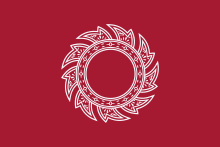Siam Empire
| 1782–current | |

A red flag with a white Sudarshana Chakra of Vishnu which is used as the symbol of Chakri Dynasty. Adopted by King Rama I (Buddha Yodfa Chulalok).
|
|
| Preceded by | Thonburi Kingdom |
|---|---|
| Monarch |
Phutthayotfa Chulalok (King Rama I) Phutthaloetla Naphalai (King Rama II) Nangklao (King Rama III) Mongkut (King Rama IV) Chulalongkorn (King Rama V) Vajiravudh (King Rama VI) Prajadhipok (King Rama VII) |
The Rattanakosin Kingdom (Thai: อาณาจักรรัตนโกสินทร์, IPA: [āːnāːt͡ɕàk ráttanákōːsǐn]) is the fourth and present traditional centre of power in the History of Thailand (or Siam). It was founded in 1782 with the establishment of Bangkok as the capital city.
The maximum zone of influence of the Rattanakosin Kingdom included the vassal states of Cambodia, Laos, Burmese Shan States, and some Malay kingdoms. The kingdom was founded by King Rama I (Phra Phutthayotfa Chulalok) of the Chakri Dynasty. The first half of this period was characterised by the consolidation of the kingdom's power and was punctuated by periodic conflicts with Burma, Vietnam and Laos. The second period was one of engagements with the colonial powers of Britain and France in which Siam managed to remain the only Southeast Asian nation to maintain its independence.
Internally the kingdom developed into a modern centralised nation state with borders defined by its interactions with Western powers. Significant economic and social progress was made, marked by an increase in foreign trade, the abolition of slavery and the expansion of formal education to the emerging middle class. However, the failure to implement substantial political reforms culminated in the 1932 revolution and the abandonment of absolute monarchy in favour of a constitutional monarchy. This article covers events up until 1932; for subsequent history, see History of Thailand (1932–73).
...
Wikipedia
